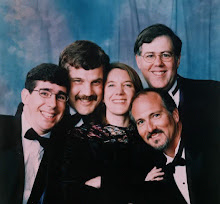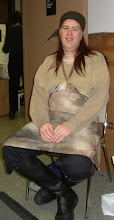The St. Louis Symphony Performs Aida
From time to time major orchestras perform full operas in semi-staged productions. Last year - November 2013 - the St. Louis Symphony performed a semi-staged production of "Peter Grimes." It is simply terrific. So, I was interested and excited to see that Music Director had chosen "Aida" to conclude the orchestra's 2014/2015 season. The first performance was last night and it was a decidedly mixed event. The orchestra and the chorus were simply outstanding. The orchestra had engaged a video artist to provide background projections which engulfed the orchestra throughout. These I thought were pretty successful (I did tire of the winking eye, however). Overall the lead singers were good, some better than others however.For me the stand outs of the evening were Solomon Howard as the King and Ekaterina Semenchuk as Amneris. The King is a secondary role, but yet Solomon Howard's powerful bass voice blew me away. He was for me the star of the evening. He is the only one of the singers who has sung at the Met, and I can see why. I want to hear more of this young bass! I liked Semenchuk very much. She had power across her range and gave us an intense Amneris. I would have a liked a little more subtlety in places, but she certainly gave us an strong performance of the role. The tenor Antonello Palombi was a bit uneven but overall good and did seem to be one of the few cast members who actually attempted to act. Gordan Hawkins was a strong Amonasro and Alexander Vinocradov was fine, though a little underpowered as the High Priest Ramfis. I am sorry to say that I felt that Lucretia Garcia as Aida was the weakest member of the cast. Vocally she had bursts but overall she was overpowered by the rest of the cast and her acting was simply nonexistent. Two local singers as the Messenger and the High Priestess did a nice job. It was nice to actually have the High Priestess and the Harp onstage for a change.
The first two acts were the strongest of the evening, largely because of the chorus. Timing was good and the orchestra and chorus and soloists were well paced, though balance between the singers and the orchestra was an annoying problem throughout. The triumphal scene was simply thrilling. But after the intermission this all seemed to disappear. Act 3 simply did not hang together. Tempi were odd in places and the act just didn't hang together. Largely I think this is because act 3 is Aida's act and her weaknesses were particularly on display. It did not help her, or Amonasro, that the decision was made to put her on a platform behind the orchestra for her aria and the subsequent scene with her father. Both singers had trouble being heard over the orchestra. Hawkins was completely covered during his major outburst. Had they been downstage I think this would have helped.
The major misstep though took place during the judgment scene however. During acts 1 and 2 the entire chorus were in seats behind the orchestra. All of the chorus parts were taken by the one chorus (the score divides the chorus into groups: Priests, Priestesses, Attendants on Amneris, Soldiers, Crowd, Prisoners, etc.). Given the venue, that was fine with me. But for acts 3 and 4 the chorus is largely unseen so they positioned them in the foyer behind the audience. It worked well for most of the 2nd half - until the judgment scene. The score calls for the priests to return to the stage at the conclusion for the last bit which includes Amneris' cursing of the priests. For me, this is the highlight of the opera and musically the most exciting and dramatic moment. For what I am sure were logistical reasons the priests never appeared on stage but remained offstage. Consequently the finale of that scene basically turned into a monologue by Amneris since one could not hear the chorus or Ramfis over the orchestra. It was a huge disappointment. I understand the problem, but it seems to me they could have brought the priests into the hall at least. Also, it might be worth noting that when done on stage the entire chorus is not used as priests, it is usually a small subset. Obviously it would have made it easier to bring a smaller group of strong basses and baritones on stage for that finale. I believe there was a way to do it, but they didn't and it kind of ruined the ending.
On the other hand, the final tomb scene had the chorus in the hall on either side of the auditorium. This was lovely. This chorus has a beautiful sound. Amy Kaiser, the chorusmaster, obviously spends time shaping the sound and it shows.
A couple other observations: It is a major pet peeve of mine when professional musicians practice their challenging parts during the intermission or before the concert. Come on, St Louis symphony musicians you are better than this. I do not want to hear the principal oboe practice "Patria mia" or the tuba practice his hard parts. It is distracting and unprofessional.
The St. Louis Symphony has a new Bass Clarinet player - Tzuying Huang - she is terrific! I love her playing. She is a wonderful musician. Even in the relatively short bass clarinet solo in act 4 she distinguished herself! Brava!
Amy Kaiser is obviously a wonderful chorusmaster. Everything I have heard from the chorus over the 6 years I have been attending StLSO concerts has been top notch. However, as the pre-concert lecturer she was terrible. She seemed unprepared and was making it up as she went. The trumpets for the Triumphal March, for example, are NOT called "Aida Trumpets" they are called Heralding Trumpets and they are not unique to Aida, in fact the US Military has an ensemble of them for ceremonial use. (ok - I stand corrected - these trumpets copy historical Egyptian trumpets and are modeled on Fanfare or Heralding Trumpets but only have one valve in order to play one tune - here is an article: http://www.21stcenturybrass.com/giuseppe-verdi-aida-trumpet/ ). And her comment about the ballet was downright insulting. We will have the opportunity, she told us, to hear the ballets without the distraction of dancers. What? Isn't that was a ballet is for? And who says dancers are distracting. Some of us like dancers. I think she was trying to pay a compliment to the orchestra but it was not necessary to put down dancers in order to do it. Her pre-concert talk was an embarrassment, frankly.
As wonderful as the projections were one wonders why the solo singers were not similarly costumed. The only one whose dress added to the overall production was, not surprisingly, Palombi as Rhadames. He was the only one of the cast (except for the King) who was really engaged in his role. Ramfis looked like a stock-broker or a Mormon missionary. Surely some kind of minimal costuming could have done done to add to the feel created by the projections. As it was the singers lack of acting and lack of costuming detracted from the projections and from the production. One is left to wonder why bother?
I came away thinking that perhaps Aida does not work in a concert production. Certainly there were some thrilling moments. But the overall experience was very mixed and it was almost that the piece was too much for the context. David Robinson is a wonderful conductor and his work at the Met has been top notch. But it has all been in contemporary opera. After last night I wonder if he really is able to do romantic opera. His tempi were odd in places, some of the transitions were disjunct, his overall dramatic sense did not seem to prevent the problems listed above, and the orchestra consistently overpowered the singers, even the chorus. He did not seem to be able to bring them into balance. Perhaps Aida needs to remain as a stage work.
The stage at Powell Hall at intermission with some of the projections.



